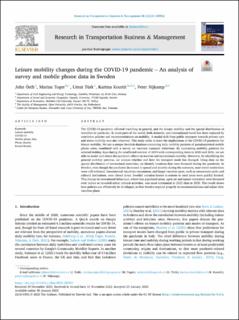| dc.description.abstract | The COVID-19 pandemic affected travelling in general, and the leisure mobility and the spatial distribution of travellers in particular. In most parts of the world, both domestic and international travel has been replaced by restrictive policies and recommendations on mobility. A modal shift from public transport towards private cars and micro-mobility was also observed. This study seeks to trace the implications of the COVID-19 pandemic for leisure mobility. We use a unique Swedish database containing daily mobility patterns of pseudonymised mobile phone users, combined with a survey on vacation transport behaviour. By contrasting mobility patterns for selected holiday days during the unaffected summer of 2019 with corresponding dates in 2020 and 2021, we are able to model and detect the pandemic effects on tourism and recreational mobility. Moreover, by identifying the general mobility patterns, we analyse whether and how the transport mode has changed. Using data on the spatial distribution of recreational amenities, we identify locations that were favoured during the pandemic. In Sweden, even though the pandemic decreased in spread and severity during the summers, most travel restrictions were still enforced, international vacations uncommon, and larger vacation spots, such as amusement parks and cultural institutions, were closed down. Swedish vacation homes in remote or rural areas were quickly booked. This change in recreational behaviour, where less populated areas, open air and nature recreation were favoured over indoor or crowded urban cultural activities, was more substantial in 2021 than in 2020. This result shows how policies can effectively be developed, so that Swedes respond properly to recommendations and adjust their vacation plans. | en_US |

